24 Hours Hotline: +86 137-3541-1378
Email:[email protected]
24 Hours Hotline: +86 137-3541-1378
Email:[email protected]
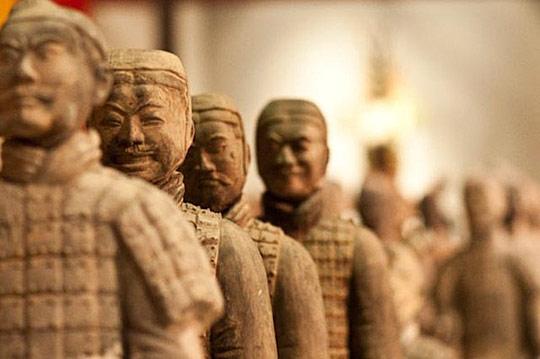
Terracotta Army or Terracotta Warriors (Chinese: ??????)
Brief introduction
Known as "the Eight Wonders of the world", the museum shows a surprisingly high level in sculpture which is listed as the most significant discovery of the 20th century. It is a super large collection of life-size terra cotta sculptures in battle formations, reproducing the mega imperial guard troops of Emperor Qin Shi Huang (259 - 210BC), the first emperor of the first unified dynasty of Imperial China. Up to now, there has discovered a total of 179 accompanying burial pits of different connotations and various shapes in Emperor Qin's Mausoleum area.
The figures, dating from approximately the late third century BCE, were discovered in 1974 by local farmers in Lintong District, Xi'an, Shaanxi province. With its large scale and overwhelming momentum, the Terracotta Warriors was listed into 5A world cultural heritage in 1987. The figures vary in height according to their roles, with the tallest being the generals. The figures include warriors, chariots and horses. Estimates from 2007 were that the three pits containing the Terracotta Army held more than 8,000 soldiers, 130 chariots with 520 horses and 150 cavalry horses, the majority of which remained buried in the pits nearby Qin Shi Huang's mausoleum. Other terracotta non-military figures were found in other pits, including officials, acrobats, strongmen and musicians.
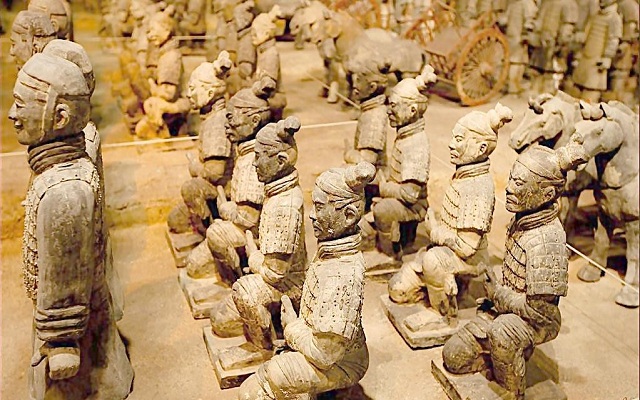
History of Terracotta Army
The Terracotta Army was discovered on 29 March 1974 to the east of Xi'an in Shaanxi province by farmers digging a water well approximately 1.5 kilometres (0.93 mi) east of the Qin Emperor's tomb mound at Mount Li (Lishan), a region riddled with underground springs and watercourses. The construction of the tomb was described by historian Sima Qian (145–90 BCE) in his most noted work Shiji, written a century after the mausoleum's completion.
Work on the mausoleum began in 246 BCE soon after Emperor Qin (then aged 13) ascended the throne, and the project eventually involved 700,000 workers. Geographer Li Daoyuan, writing six centuries after the First Emperor's death, recorded in Shui Jing Zhu that Mount Li was a favoured location due to its auspicious geology, "famed for its jade mines, its northern side was rich in gold, and its southern side rich in beautiful jade; the First Emperor, covetous of its fine reputation, therefore chose to be buried there". Sima Qian wrote that the First Emperor was buried with palaces, towers, officials, valuable artifacts and wondrous objects. According to this account, 100 flowing rivers were simulated using mercury, and above them the ceiling was decorated with heavenly bodies below which were the features of the land. Some translations of this passage refer to "models" or "imitations;" however, those words were not used in the original text, which makes no mention of the terracotta army.
High levels of mercury were found in the soil of the tomb mound, giving credence to Sima Qian's account.
Later historical accounts suggested that the tomb had been looted by Xiang Yu, a contender for the throne after the death of the first emperor. However, there are indications that the tomb may not have been plundered.
For centuries, occasional reports mentioned pieces of terracotta figures and fragments of the Qin necropolis – roofing tiles, bricks and chunks of masonry. This discovery prompted Chinese archaeologists to investigate, revealing the largest pottery figurine group ever found in China. A museum complex has since been constructed over the area, with the largest pit enclosed within with a large structure.
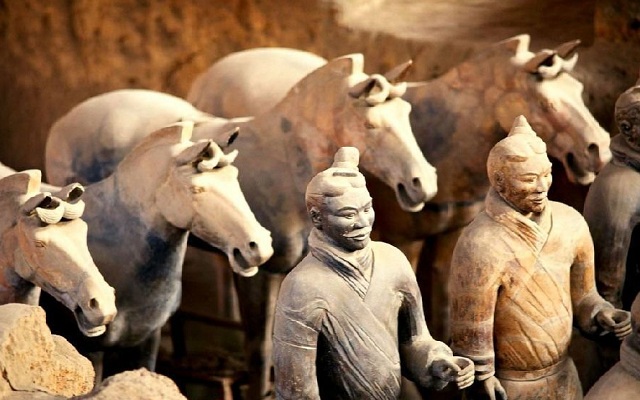
What to see in Terracotta Army
The main pit of the four which contain the discovered army measures 230 x 62 metres and is 4 to 6 metres deep. It had around 6,000 slightly larger than life-size depictions of infantrymen (1.8-1.9 metres tall), chariots and horses. The pit, originally with wooden columns supporting a wood beam ceiling, is partitioned by 10 brick-lined corridors. The floor was made from compacted earth which was then paved with over 250,000 ceramic tiles. The second pit, which is slightly smaller and R-shaped, had some 1,400 figures in it. In keeping with an obvious attempt to recreate exactly a real army, pit 3, measuring 21 x 17 metres, contains commanders and resembles a command post in the field.
To protect his tomb or perhaps even to ensure he had a handy bodyguard in the next life, Shi Huangdi went a whole lot better than his predecessors. Rulers in ancient China commonly had two or three statues to stand as guardians outside their tombs but Huangdi went for a whole army of them. The Terracotta Army is actually one of only four in all likelihood as that portion so far excavated - 1.5 km distant from the mausoleum - is on the eastern side and is probably duplicated on the other three sides of the tumulus. Even this one-quarter section has not been fully excavated with only three of its four pits having been fully explored by archaeologists.
Pits
Four main pits approximately 7 metres (23 ft) deep have been excavated. These are located approximately 1.5 kilometres (0.93 mi) east of the burial mound. The soldiers within were laid out as if to protect the tomb from the east, where all the Qin Emperor's conquered states lay.
Pit one, which is 230 metres (750 ft) long and 62 metres (203 ft) wide, contains the main army of more than 6,000 figures. Pit one has 11 corridors, most of which are more than 3 metres (10 ft) wide and paved with small bricks with a wooden ceiling supported by large beams and posts. This design was also used for the tombs of nobles and would have resembled palace hallways when built. The wooden ceilings were covered with reed mats and layers of clay for waterproofing, and then mounded with more soil raising them about 2 to 3 metres (6 ft 7 in to 9 ft 10 in) above the surrounding ground level when completed.
Pit two has cavalry and infantry units as well as war chariots and is thought to represent a military guard. Pit three is the command post, with high-ranking officers and a war chariot. Pit four is empty, perhaps left unfinished by its builders.
Some of the figures in pit one and two show fire damage, while remains of burnt ceiling rafters have also been found. These, together with the missing weapons, have been taken as evidence of the reported looting by Xiang Yu and the subsequent burning of the site, which is thought to have caused the roof to collapse and crush the army figures below. The terracotta figures currently on display have been restored from the fragments.
Other pits that formed the necropolis also have been excavated. These pits lie within and outside the walls surrounding the tomb mound. They variously contain bronze carriages, terracotta figures of entertainers such as acrobats and strongmen, officials, stone armour suits, burials sites of horses, rare animals and labourers, as well as bronze cranes and ducks set in an underground park.
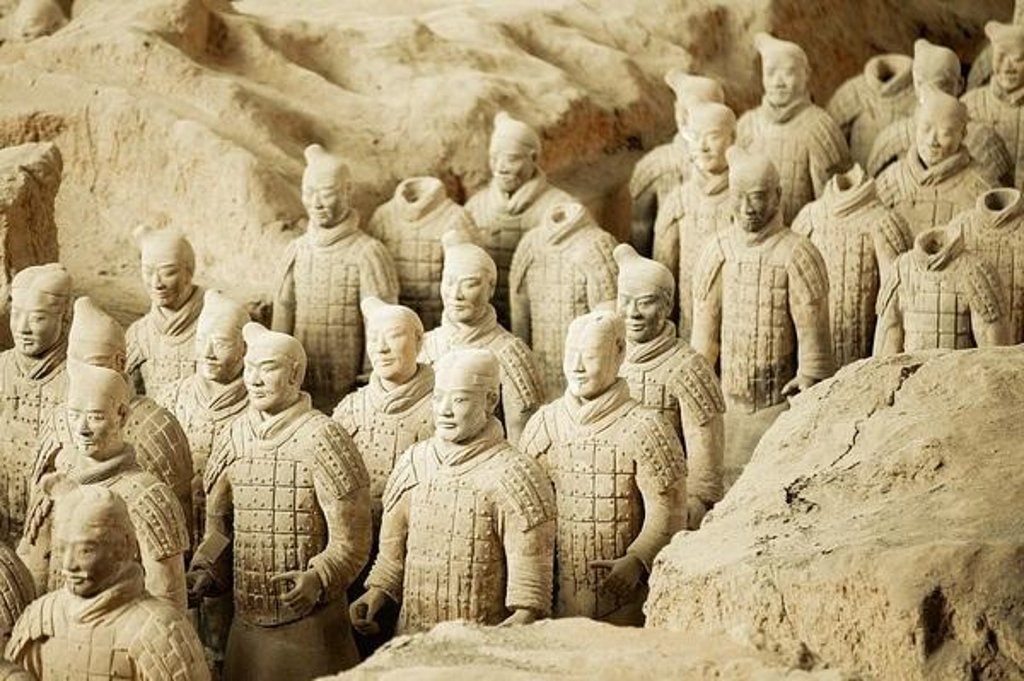
Warrior figures
The terracotta figures are life-sized. They vary in height, uniform, and hairstyle in accordance with rank. The faces appear different for each individual figure, scholars however have identified 10 basic face shapes. The figures are of these general types: armored warriors; unarmored infantrymen; cavalrymen who wear a pillbox hat; helmeted driver of chariots with more armor protection; spear-carrying charioteers; kneeling archers who are armored; standing archers who are not; as well as generals and other lower-ranking officers. There are however many variations in the uniforms within the ranks, for example, some may wear shin pads while others not; they may wear either long or short trousers, some of which may be padded; and their body armors vary depending on rank, function, and position in formation. There are also terracotta horses placed among the warrior figures.
Originally, the figures were painted with bright pigments, variously coloured pink, red, green, blue, black, brown, white and lilac. The coloured lacquer finish and individual facial features would have given the figures a realistic feel. However, much of the colour coating had flaked off or become greatly faded.
Some scholars have speculated a possible Hellenistic link to these sculptures, due to the lack of life-sized and realistic sculptures prior to the Qin dynasty. They argued that potential Greek influence is particularly evident in some terracotta figures such as those of acrobats, as well as the technique used for casting bronze sculptures.
Construction
The terracotta army figures were manufactured in workshops by government laborers and local craftsmen using 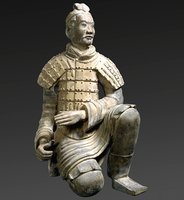 local materials. Heads, arms, legs, and torsos were created separately and then assembled by luting the pieces together. When completed, the terracotta figures were placed in the pits in precise military formation according to rank and duty. The faces were created using molds, and at least ten face molds may have been used. Clay was then added after assembly to provide individual facial features to make each figure appear different. It is believed that the warriors' legs were made in much the same way that terracotta drainage pipes were manufactured at the time. This would classify the process as assembly line production, with specific parts manufactured and assembled after being fired, as opposed to crafting one solid piece and subsequently firing it. In those times of tight imperial control, each workshop was required to inscribe its name on items produced to ensure quality control. This has aided modern historians in verifying which workshops were commandeered to make tiles and other mundane items for the terracotta army.
local materials. Heads, arms, legs, and torsos were created separately and then assembled by luting the pieces together. When completed, the terracotta figures were placed in the pits in precise military formation according to rank and duty. The faces were created using molds, and at least ten face molds may have been used. Clay was then added after assembly to provide individual facial features to make each figure appear different. It is believed that the warriors' legs were made in much the same way that terracotta drainage pipes were manufactured at the time. This would classify the process as assembly line production, with specific parts manufactured and assembled after being fired, as opposed to crafting one solid piece and subsequently firing it. In those times of tight imperial control, each workshop was required to inscribe its name on items produced to ensure quality control. This has aided modern historians in verifying which workshops were commandeered to make tiles and other mundane items for the terracotta army.
Weaponry
Most of the figures originally held real weapons such as spears, swords, or crossbows, and the use of actual weapons would have increased the figures' realism. Most of the original weapons, however, were looted shortly after the creation of the army, or have rotted away. Nevertheless, many weapons such as swords, spears, lances, battle-axes, scimitars, shields, crossbows, and arrowheads have been found in the pits. Over 40,000 bronze items of weaponry have been recovered from the pits, with most of these arrowheads which are usually found in bundles of 100 units. Studies of these arrowheads suggests that they were produced in small units of self-sufficient, autonomous workshops that produced finished items in a production process referred to as cellular production or Taoism. There are also hundreds of crossbow triggers, and smaller number of other weapons such as bronze swords, and daggers.
Some of these weapons, such as the swords, are sharp and were coated with a 10–15 micrometre layer of chromium dioxide that kept the swords rust-free for 2,000 years. The swords contain an alloy of copper, tin, and other elements including nickel, magnesium, and cobalt. Some carry inscriptions that date their manufacture to between 245 and 228 BCE, indicating that they were used as weapons before their burials.
An important element of the army is the chariot, of which four types were found. In battle the fighting chariots formed pairs at the head of a unit of infantry. The principal weapon of the charioteers was the ge or dagger-axe, an L-shaped bronze blade mounted on a long shaft and used for sweeping and hooking at the enemy. Infantrymen also carried ge on shorter shafts, ji or halberds and spears and lances. For close fighting and defence, both charioteers and infantrymen carried double-edged straight swords. The archers carried crossbows, with sophisticated trigger mechanisms, capable of shooting arrows farther than 800 metres (2,600 ft).
How to get there
Bus Routes:
1. No. 914, 915, or Special Line 101, and get off at Terracotta Warriors Museum
2. No.306 or Tourist Line No.5 to get there, which costs 7RMB and 1 hour.
Information
Admission Fee: CNY120 for low season (Dec.1-Feb.29), CNY150 for high season (Mar.1-Nov.30)
Opening hours: 8:30-18:30
Time for Visit: 3 hours
Tour Terracotta Warriors with Xian Priavte Tour
All the following tours are recommended by 98% of our clients. They are private tours with an English-seapking local guide, a private vehicle and experienced local driver. Usually the tour service starts from Xian hotel/Xian train station/Xian aiport and finishes at the moment you say goodbye to your guide at the Xian hotel/Xian train station/Xian airport.
If the above tours are not on your list, creat your own Terracotta Warriors tour following our suggestions. Based in Xi'an and focused on Xi'an, we are a local team to show you the historic Xi'an, we can customize private tours, tour itinerary and tour packages to cater to the needs of individual tourists as well as small group tours including families, friends and business colleagues. Please refer to Xian tours for more Xian tour packages or send us your inquiry by email.
Prev: No previous link
Next: Huashan Mountain
1. How long does it take to visit the Terracotta Warriors?
A standard visit to the Terracotta Warriors Museum typically takes 2 to 2.5 hours. Most visitors spend:
Around 60 minutes in Pit 1, the main excavation site with thousands of life-sized clay soldiers.
An additional 30–40 minutes exploring Pits 2 and 3, which offer insight into the army’s command structure and military formation.
About 20–30 minutes in the Bronze Chariot Exhibition Hall to view finely crafted bronze artifacts.
For a deeper understanding, guided tours may extend the visit to approximately 3 hours. The museum grounds are generally flat and well-maintained, making it suitable for all ages. We recommend arriving early to avoid crowds and wearing comfortable walking shoes.
2. I am planing a trip to Xian during Chinese New Year, will the Terracotta Warriors be closed?
The Terracotta Warriors and Horses Museum remains open during the Chinese New Year holiday, as it is one of China’s most popular tourist attractions. However, please note that this is a peak travel period, so the site can be very busy, and tickets may sell out quickly.
We recommend booking your tickets and tour in advance to ensure availability and a smoother experience. Let us know if you’d like assistance with arrangements—we’d be happy to help.
3. Is the wheelchair accessible in Terracotta Warriors and Museum?
Yes, the Terracotta Warriors and Museum is wheelchair accessible. The main exhibition halls, including Pits 1, 2, and 3, are equipped with barrier-free paths and ramps suitable for wheelchair users. Elevators are available where needed, and the museum staff are generally helpful and accommodating. Wheelchairs can also be rented on-site at the service center near the entrance. We recommend contacting the museum or your tour provider in advance to ensure availability and assistance if needed.
Yes, the official website does offer online ticket booking, but it's only available in Chinese, which can make it difficult for foreigners to use. If you’re not familiar with the language, it's challenging to make a reservation on your own. While you could ask someone who speaks Chinese to help, the easiest and most reliable option is to book through us—we’d be happy to assist you with securing your train tickets in advance.
There are several ways to get to the Terracotta Warriors from the airport:
Airport Shuttle + Tourist Bus: Take the airport shuttle bus to Xi’an Railway Station (about 1 hour), then transfer to Tourist Bus No. 306 to the Terracotta Warriors. The total journey takes approximately 2 hours.
Airport Shuttle to Lintong: Take the airport shuttle bus to Lintong, then transfer to Lintong Bus No. 101. This bus ride takes about 15 minutes to reach the Terracotta Warriors.
Taxi or Private Transfer: The most convenient option is to take a city taxi or book a private transfer directly from the airport to the Terracotta Warriors. If you arrive around noon or later, we recommend this option to make the most of your time.
6. How much cost for the Terracotta Warriors tickets? Any discount for children?
The entrance fee for the Terracotta Warriors is CNY 150 during the peak season (March to November) and CNY 120 during the low season (December to February).
There are discounts available for children:
Free entry for children under 1.2 meters in height.
Half-price tickets for children between 1.2 and 1.5 meters.
Students studying in China can also enjoy discounted tickets with a valid student ID card.
If you book a tour with us, we’ll be happy to assist in purchasing the tickets and applying any eligible discounts.
7. What are the opening hours of the Terracotta Warriors?
The Terracotta Warriors have different opening hours depending on the season:
Peak Season (March 16 – November 15):
Ticket check-in: 08:30 – 17:00
Opening hours: 08:30 – 18:30
Low Season (November 16 – March 15):
Ticket check-in: 08:30 – 16:30
Opening hours: 08:30 – 18:00
If you depart from Xi’an city at 12:30 PM, it takes about 1 hour to reach the site, which still gives you ample time (2–3 hours) to explore before the last entry time. It's perfectly doable for a half-day visit.
The best time to visit the Terracotta Warriors is during spring (March to early June) and autumn (September to early November) when the weather is pleasant and crowds are lighter.
To avoid the crowds, we recommend:
Arriving early in the morning, around 8:30 AM, when the site just opens.
Avoiding weekends and public holidays, especially during Chinese New Year and National Day (Oct 1–7).
Booking a private tour, which allows for better timing and a smoother experience.
Yes, luggage storage is available at the Terracotta Warriors site. You can store your luggage free of charge at the Tourist Information Center, located on the left side of the Ticketing Office.
We kindly remind you to keep important personal belongings with you during the tour, such as your passport, cash, camera, and mobile phone, for security purposes. Let us know if you need any assistance with directions or tour arrangements.
10. Can you arrange a Private Terracotta Warriors Tour that picked up from Xian hotel?
Yes, we can absolutely arrange a private Terracotta Warriors tour with pickup from your hotel in Xi’an, or any hotel within the city.
This customized private tour includes:
A professional English-speaking guide
Comfortable private vehicle with a licensed driver
Hotel pickup and drop-off
Entrance ticket to the Terracotta Warriors & Museum
Your guide will pick you up directly from your hotel, take you to visit the Terracotta Warriors and Museum, and return you to your hotel after the tour. The itinerary is 100% flexible, so you can choose the start time and let your guide know any preferences or special interests during the tour.
11. Is photography allowed in Terracotta Warriors and Horses Museum?
Yes, photography is allowed in the public areas of the Terracotta Warriors and Horses Museum. However, please note that the use of flash and tripods is strictly prohibited in order to protect the artifacts. We recommend turning off your flash and being mindful of signage and staff instructions during your visit.
12. Where can i buy a figure of Terracotta Warrior as a souvenir bring back home?
Terracotta Warrior replicas are among the most popular souvenirs for visitors to Xi’an. You can find them at several locations, including the official gift shop at the Terracotta Warriors Museum, the Muslim Quarter, and shops at Xi’an Airport or the train station. These replicas come in a variety of styles—some are handsome, humorous, fat, slim, young, or old, making them fun and unique gifts. Prices vary depending on size, material, and craftsmanship. In general, you'll find better prices and more variety in Xi’an’s downtown markets compared to the airport or train station.
Duration:6-8 hours
Attractions(Cities):Terracotta Warriors and Horses Museum, Bell Tower, Muslim Quarter
Tour Style:If you're short on time but eager to experience Xi'an, our Xi'an private tour is the perfect solution. This all-inclusive one-day tour includes visits to the world-famous Terracotta Warriors, a UNESCO World Heritage Site, where you’ll marvel at thousands of life-sized statues. You’ll also explore the Bell Tower, a historic landmark offering panoramic views of the city, and stroll through the lively Muslim Quarter, sampling local delicacies and experiencing vibrant cultural blends. With hotel pickup, a professional guide, comfortable transport, and all entrance fees included, this Xi'an private tour offers a seamless and enriching experience, allowing you to uncover the best of Xi'an’s rich history and culture.
Duration:6-8 hours
Attractions(Cities):Xi'an Ancient City Wall, Big Wild Goose Pagoda, Xian Great Mosque, Muslim Quarter
Tour Style:This Xian city tour offers an immersive journey into the rich history and culture of this ancient city. Begin your day at the Shaanxi History Museum, where you'll explore China's long-standing civilization through its precious artifacts. Next, visit the Big Wild Goose Pagoda to experience the deep roots of Buddhist culture. At the Xi'an Great Mosque, marvel at the unique Islamic architectural artistry. Finally, stroll through the vibrant Muslim Quarter, where you'll savor the diverse flavors of Xi'an's food culture. This tour provides not only cultural enrichment but also exceptional service to ensure a memorable and enjoyable experience.
Duration:4-5 Hours
Attractions(Cities):Terracotta Warriors, Muslim Quarter
Tour Style:Experience the awe-inspiring Terracotta Army with our exclusive Xi'an Terracotta tour. Skip the crowds and enjoy a personalized exploration of this world-famous site, one of the "Eight Wonders of the World," with a knowledgeable local guide. With flexible pacing, you’ll have ample time to marvel at over 8,000 life-sized figures guarding the tomb of China’s first emperor, Qin Shi Huang. This tailored tour includes convenient city transportation, entrance fees, and expert guidance, ensuring a seamless and immersive experience. Dive deep into the history, culture, and fascinating stories of the Terracotta Warriors, uncovering the legacy of this remarkable archaeological treasure in Xi'an.
Duration:10-12 hours
Attractions(Cities):Terra-cotta Warriors, Local Xi 'an lunch
Tour Style:Embark on a seamless day trip to Terracotta Warriors from Beijing with a comfortable high-speed train ride to Xi'an. Upon arrival, your private, knowledgeable guide will greet you at the station and take you directly to the world-famous Terracotta Warriors, a UNESCO World Heritage Site. There, you'll marvel at the thousands of life-sized sculptures that once guarded the tomb of China's first emperor, Qin Shi Huang each figure uniquely detailed and steeped in ancient history. After your in-depth visit, enjoy a delicious local lunch featuring Xi'an specialties before returning to the train station for your journey back to Beijing. This well-organized private tour is ideal for travelers who want to experience one of China's most iconic sights in a single, hassle-free day.
Duration:8 hours
Attractions(Cities):Mt Huashan
Tour Style:Embark on an unforgettable Xi'an to Huashan Day Trip Tour, visiting one of China’s Five Sacred Mountains. With your expert guide, you’ll follow the most efficient route to explore the breathtaking beauty of Huashan, including stunning sunrise and sunset views, a sea of clouds, and majestic mountain scenery that has captivated visitors for centuries. Along the way, you’ll visit key sites that offer insights into Taoism, ancient Chinese culture, and the mountain’s rich history. This all-inclusive tour includes hotel pickup and drop-off, private car service with a professional driver, expert guidance, and entrance fees, ensuring a smooth, enriching experience and a deep connection with this iconic destination.
Wechat: Chinaprivatetour
24 Hours Hotline:
+86 137-3541-1378
(Your Privacy is Protected)
1 to 1 tailor-made service from our professional travel advisors for the most sophisticated
Constantly excellent reviews for attraction, hotel and service Competitive price
Local experts provide quality tours Best selected knowledgeable local guides Authentic local restaurants
7*24 hours available to create you a worry-free tour. No Hidden Fees and absolutely no pressure to buy. Secured









Copyright © 2017 www.xianprivatetour.com All rights reserved. 浙ICP备18056007号-6